Last week, we looked at this pretty little vintage handkerchief adorned with violas stitched in tent stitch.
One question that came up was how to tell if an embroidered handkerchief is stitched by hand or by machine.
I’m not really an expert on this subject, but there are a few indications that I look for, that point to machine embroidery instead of hand embroidery on vintage pieces.
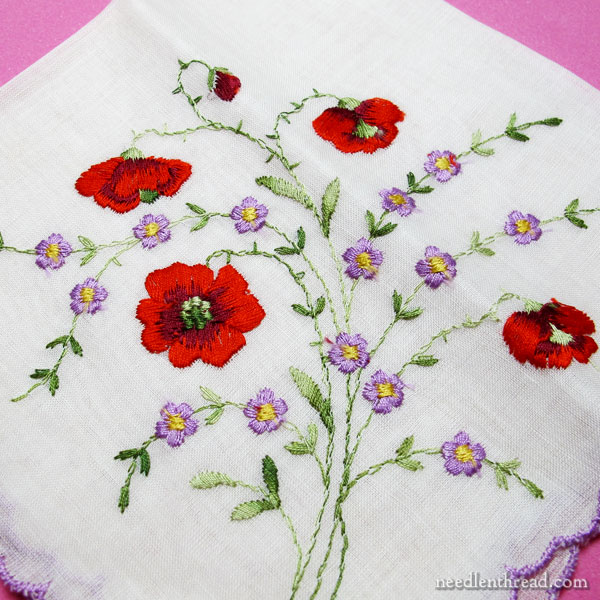
The Embroidery Machine in History
Embroidery machines have been around for a while, the first one being created in the early 1800’s, even before the first patented sewing machine.
There’s an interesting infographic here on the history of the sewing machine. So, although inventors dabbled with sewing machines in the late 1700’s, before the first one was ever patented, the first embroidery machine was made in France, in 1828.
This was followed by a Swiss embroidery machine in 1863 (created by Isaac Groebli), called the Schiffli, which was later improved upon by his son.
Eventually, in the early 1900’s, Singer developed an embroidery machine with multiple heads.
The embroidery machine has continued to develop since then, and today, we have super-duper-fancy digitized home embroidery machines readily available for anyone who wants them and can afford them.
Machine or Hand Embroidered?
When machine embroidery first came about and even today, there have been those who assert that you can’t tell the difference between something that is machine embroidered and something that is hand embroidered.
I think most people who are familiar with hand embroidery and have some knowledge of textiles in general can tell the difference.
Because serious embroiderers are immersed in their needle pursuits, because we’re familiar with the stitches and the way they naturally work and we’re familiar with threads and how they play together, we can more easily recognize the difference between something that is machine embroidered and something that is hand embroidered.
Now, don’t get me wrong. Machine embroidery definitely has its place and its plusses! I’m not contending that one is better than the other. (Ahem – I’m not.) I prefer hand embroidery for hand embroidery, but I also appreciate (and I’m in awe of) what can be accomplished with a machine.
But there are certainly recognizable differences between the two – machine embroidery is different from hand embroidery.
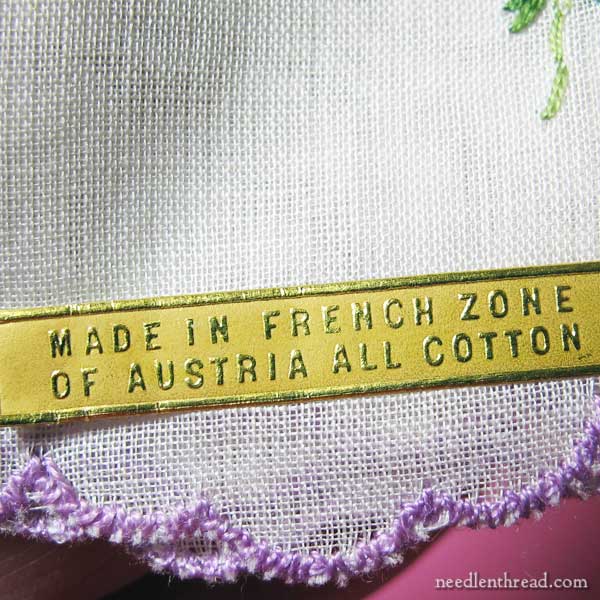
This particular handkerchief was made in the French Zone of Austria, which means it was made some time during the ten year span of Allied-occupied Austria, from 1945 through 1955.
As romantic as it sounds – that a lady, perhaps, sat at home embroidering by hand pretty little hankies to provide income in a cottage-industry type setting during tough post-war years – the handkerchief, examined closely, tells a different story.
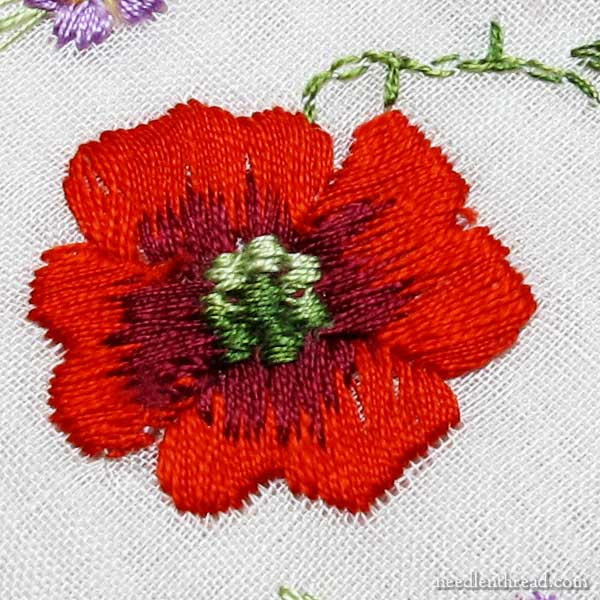
The embellishment on the handkerchief consists of large red flowers stitched in what looks like long & short stitch, smaller satin stitched purple flowers, stems in a kind of loose chain stitch, large leaves and small leaves in what looks like satin stitch and straight stitches.
Notice that the direction of the stitching is all straight, when it comes to the flower. The stitches don’t turn to follow the shape of the petals. Instead, a series of straight stitches fills each petal shape, straight across the shape.
Notice as well that the dark stitches, stitched on top of the brighter red stitches, pull into the red stitches in pairs. You might not be able to see that so well, but if you click on the photo and enlarge it, it’s a little clearer that each dark stitch actually looks more like two stitches.
Notice, too, that the satin stitched dots that make up the center of the flower are all connected. The thread continues from one dot to another, so that there’s not really a separation of dots there.
True, true, this can all be achieved by hand!
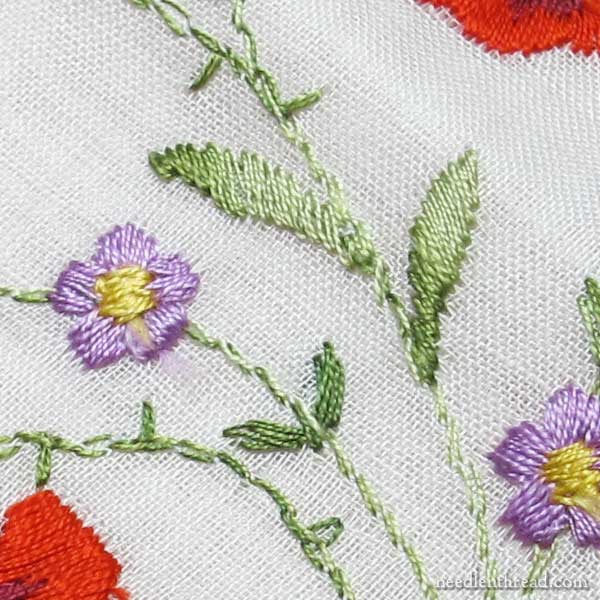
Now, let’s look at the small purple flowers – again, all stitched in apparently satin stitch, and each of the petals moving in a square kind of direction. Look as well at the apparently satin-stitched large leaves. Notice that they have kind of a zig-zaggy look to them, as if the green threads are taken from one side of the leaf over to the next, and couched down, before continuing back to the other side – like a couched surface satin stitch.
Again, this could all be done by hand.
Notice as well the stem. It sort of looks like an open chain stitch in some places, or just slanted straight stitches in other places. But the thread is always in twos.
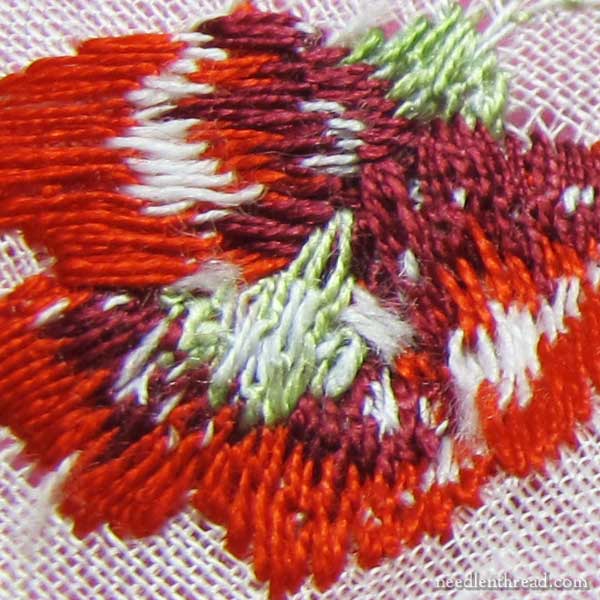
Now, let’s turn the piece over.
Wow! Look at all that white thread! And yet, on the front of the fabric, there’s no white embroidery. What’s going on here?
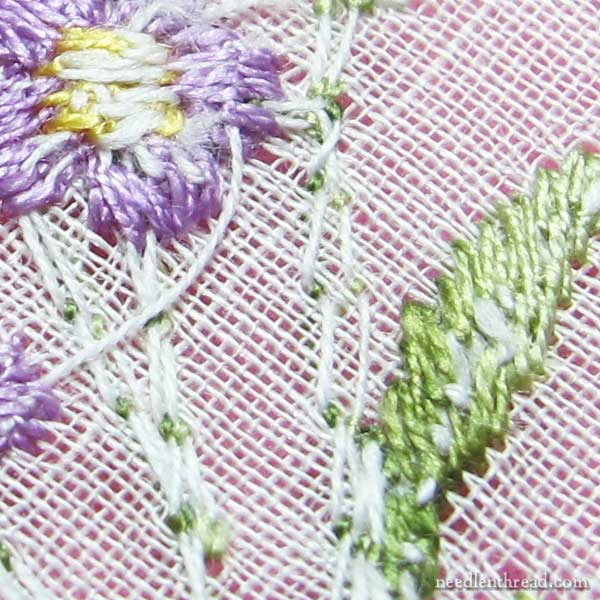
And here’s the back of the stems and leaves. More white thread – and it looks a lot like a chain stitch, when following the line of the stems.
I think this is a pretty good sign that this particular piece is machine embroidery. The bobbin thread that holds the colored threads down is white, perhaps to save on the colored threads, perhaps to save on time (if the bobbin thread is always white, you don’t have to switch to a different bobbin when switching to different colors of threads on the top).
You can also see a long white thread carrying from the large purple flower at the top of the photo to the purple flower to the lower left on the photo.
Another sign of machine embroidery is finding systematically carried threads across the back of the work. If you can follow an almost-mechanical, logical path of carried threads on the back of an embroidered item from one motif to the next without a break, it’s most likely machine embroidery.
So, the stitching on the top of this hankie is not actually satin stitch. It’s more like a chain stitch that’s pulled to the back by a bobbin thread, so that the chain stitch makes a pair of straight stitches on the front.
The argument could be made that it’s hand embroidery, done like undersided couching, but I think it is more likely machine embroidery.
Still a Treasure!
Though embellished by machine, the handkerchief is still a delicate treasure. I’m not one to write off a piece of vintage work because it was “made by machine.” It’s still a little piece of history, a tribute to a culture, a time, a place. And it’s very pretty!
Any Other Tips for Recognizing Vintage Machine Embroidered Pieces?
So, the two definite things I look for when wondering if a vintage piece is machine or hand embroidered are carried threads in a logical, systematic patter, and obvious bobbin threads, depending on the type of machine embroidery. Additionally, I look for stitches that are not normally created by machine: certain types of filling patterns, complex surface stitches like braid stitches, composite stitches, different types of drawn thread stitching – any type of stitching that is obviously hand stitching. Finally, the thread can often be a give away. Threads made for hand embroidery are often softer and not as tightly twisted as machine embroidery threads.
What about you? Do you have any tips for distinguishing embroidery by machine from embroidery by hand on vintage items? Help us learn by sharing your wisdom below!







Can you imagine what a treasure any of our current day hand-embroidery will be in a hundred years!!! 🙂
Dear Mary,
Thank you very much for this interesting piece of information. I learned quite a bit from your explanations. I sometimes used to repair machine embroidered Bavarian braces at my old job whenever the machine had left out a couple of stitches. My stitches were certainly much neater… However, the machine stithed a LOT faster. So it is definitely the more economical option.
Have a nice day, Jessica
Thanks for this very informative piece. I didn’t know that embroidery machines were made that early. Did we get Schiffli lace from the machine or was the machine used to make Schiffli lace? Just curious if they are connected.
I have machines and do both types of embroidery, one for speed and the other purely for joy. What I find is even though I have electronic cross stitcher, the stitches are not always as exactly placed as compared to hand embroidery. The machine does not see the holes in the aida cloth, or see the little gaps that are left when the stitch density is too low, but all of the stitches are mechanically the same size and almost always fills are done in long and short or satin stitch, so if I see lots of French knots, or lazy daisy stitched flowers I usually think hand embroidery and check for bobbin threads on the others. Sometimes I don’t care, but I hate it when I go to vintage shops and people try to sell me something because they say it is hand stitches when it is obviously machine done.
Hi, Debbie – the name comes from the machine….
I don’t think I’ve ever seen machine done counted cross stitch!
Oh yes, some of the Bavarian braces are stitched with a machine on a linen background in cross stitch. Others are done on wool felt in satin stitch. I also bought a traditional dress in Jordan that has cross stitch machine embroidery on it.
Mary,
I have delved into “machine embroidery” for many years..still do some on occasion. I have hand stitched “cutwork” on a bonnet my grandmother made..and then some machine cutwork that I did on a table runner…I take the hand cutwork any time….Since I am “so” into handwork again after many years because I had this deep desire to reach beyond the computer digitizing so I could understand the process by hand which I felt would enhance my digitizing. Well I was “taken aback” when I started to do handwork again after all these years. Many of the techniques applied to Machine Embroidery came from “Hand Embroidery” so therefore I was able to catch up fairly quickly with my hand work…I will tell you I fell immediately in love with “thread painting” and some other forms of hand embroidery…now I feel there is such a huge difference in the Machine made versus the Hand made…I go for the Hand made every time because the nuances in the stitching are your own and no one elses.
Could talk about it at length…..believe me….thanks for sharing your incites….brings back a lot…..
Along with the use of bobbin thread, usually white as you stated, & the continuous carryover, the rayon sheen is a giveaway – most machines use rayon floss but hand stitchers rarely do unless it is Brazilian Raised. Also, I look for random piercing which is typical of machine stitching. Hand stitchers rarely sever or cut the actual fabric yarns. But I sometimes find it difficult to compare.
Dear Mary
This is a very good lesson on how to tell the difference between hand embroidery and machine embroidery.
I have often pondered over a piece: Is it, or, is it not?
You have made the pondering easier and I thank you for that.
Sharon
Dear Mary
An interesting post and a great insight in to machine vs hand stitched items. I didn’t know that sewing machines were invented so early and from the photos above and your description of hand vs machine stitching you can tell the difference between them. I agree that there is a place a for machine embroidery as it is still an art form, but because hand embroidery is definitely a personal and individual form I prefer this kind of art form to machine pieces especially when they are factory produced. But the piece above is unique as it was embroidered at such an interesting historical time. Thanks for the very useful information on machine vs hand stitched embroidery, this will certainly help me in the future when viewing embroidered pieces.
Regards Anita Simmance
I’ve been buying a lot of embroidered items when I go to flea markets in the summer. I usually look at the thread type used, carried threads (because we all know that that’s a big no-no in Hand embroidery), if there are “zig zags” or jagged edges to the stitched design. After learning embroidery, nothing irks me more than when a seller is trying to convince me an item is hand embroidered when it’s clearly not and at outrageous prices.
I will admit that I do occasionally buy machine embroidered pieces if the design is nice or the fabric itself is of good quality.
I saw a great video on machine embroidery at the Threads site some years ago. Looks like they still have it up. The embroiderer uses a knee mechanism to widen the stitch on an industrial Juki machine. Just a bare needle with the fabric in a hoop and with stabilizer.
http://www.threadsmagazine.com/item/3833/video-manuels-free-motion-embroidery-technique
Hello Mary,
I always look at the back of the embroidery. Everyone has a unique way to finish their hand stitched work.
I like machine embroidery for patterns that can be used in quilts or crazy quilts.
I saw the machine cross stitch embroidery – it looks nice on a tightly weaved fabric, otherwise, not so good.
Enjoy the gorgeous winter day!
Jackie
Mary, I have a book published by Singer on doing machine embroidery on a treadle machine. Singer taught classes using a treadle and doing not only embroidery but cutwork and applique. I don’t think I ever had the coordination doing such intricate techniques. Oh, yes, the name of the book is Singer Instructions for Art Work and Lacework. I don’t think the book is available any more, but you might find it on ebay should you be interested. It is full of beautiful pictures of all of the techniques done on a treadle sewing machine.
Judith, I have the book you are talking about! It was reprinted in the early 1990s. It really has some amazing work in it that requires a great deal of skill to master.
I read a lot of books on old embroidery – whitework is my passion. Heather Toomer’s “Baby wore white” talks about both hand and machine embroidery – their history and gives examples of both. While Swiss embroidery laces are a boone to the heirloom sewist, nothing beats hand embroidery especially when you are making something that will be passed down. Machine embroidery is cheating period. It is like you couldn’t take the time or didn’t care enough to take the time to hand embroider the piece. Machines take out the art that is at the heart of hand embroidery.
Thanks Mary, I have just had a good look at an old handkerchief I was given as a gift. I had wondered whether it was done by machine but thought not, given how old it seems to be…
From this post I can see that it is indeed machine embroidered and in fact looks to be of a similar vintage/type to the one you show here. It is still a very lovely little handkerchief 🙂
I too do both machine & hand embroidery and can always ‘tell the difference’ but now more so than before. And I agree with the posts about folks trying to pass off machine work as done by hand, not nice…
Thanks again!
Dear Mary
Wonderful thoughts on a subject I’ve been considering a lot lately. I am doing my second quilt with hand embroider painted blocks. I’d guess 30- 40 hours per block and there are 12 of them. My sister, a costumer, says I should have just done them on her machine. “They will look the same”. I can’t see it though. Mine have subtleties like variations of thread color, a change of stitch pattern to accent a flower, a mix of textures, varying size stitches, all leading to a thread painted look. Hers are even, wear better, pre-set on design.
My style, then is better by hand. Her style, looks better by machine. It makes for a happy artist and happy family!
If I get a minute later this week, I will stitch you a sample of machine cross stitch. Cross stitcher I part of the Viking Embroidery Pro Software. I have only seen it demoed, so it will give me an excuse to play. As if I need one. I mainly use machine embroidery to make quilt labels.
Hi Mary
When using my embroidery machine, I usually use white or black bobbin thread. If the tension is correct, the bobbin thread should not show on the top. Although I like my embroidery machine, I also prefer hand embroidery.
Thank you for the lesson. Does anyone know if machine work like this was done in a factory situation or was a cottage style industry?
It actually could have been either. From early on, embroidery machines could be established in homes (in a dedicated room) and the whole family participated in the work.
Hi Mary, Just wanted to comment Machine enbroidery versus hand embroidery. Afew months ago I had the option of getting a new sewing machine that had an embroidery module I declined as I am a hand embroiderer and I hope you will agree with me that by hand is the stitchers own work with the little mistakes that can occur and it makes it their own. Whereas by machine it is just too perfect. I am a perfectionist and will unpick if its not right. I had a compliment on a thread painted flower piece that she thought I had done it by Machine. Raewyn B
When someone asks me if an item is hand stitched or not, the first thing I do is look at the back. If there is the tell-tale white thread, then it’s not! Actually, if the underside is covered with stitching like the topside, then is is most likely not. I didn’t realize I was doing it, but I then looked at the stitches to see if they were hand made; if they looked like mine looked. I have actually been asked this three times that I can remember. I’m going to go look at my collection of old handkerchiefs and see if any are machine made.
Interesting article as always. I regularly mix hand and machine embroidery in a piece, exploiting their different textures.
Superb post, as usual 🙂
My Mom did some Gorgeous & intricate machine embroidery on her simple hand-driven Singer sewing machine. No digitisation, or treadle. It was mesmerising watching her coordinated, rapid hand movements, manoeuvring the hoop with left hand & spinning the wheel with right, and creating lovely forms. She even did a kind of couching/bullion over Needles !!!
So, yes, it is an art form in itself.
However I still prefer hand embroidery (she did too, & did not teach us m/c embroidery coz it really taxed the eyes.).
Anyway, this background is to confirm that I have held at least one form of machine embroidery while making the other.
So, your observations are spot on! Including the thread choice, as mentioned in the comments.
There is one other possible telltale . Machine embroidered section is slightly more dense & Stiff to the touch, than hand embroidered piece. Reason could be a combination of thread, stitch, amount of thread per area not just above but also on the wrong side. Or something else/more ?
My 2-bits.
I have several embroidery machines, but also do a lot by hand, MY hand! I can always tell the difference, but it amazes me just how many people can not. I have noticed that nearly 100% of people that can’t see the difference have absolutely NO textile/sewing/embroidery skill at all. While people with at least a basic knowledge, or observant eyesight, can spot the differences. I use the machines for completely different purposes, while my HANDS work on different projects. Such as multiple towels, table coverings, curtains, that’s mainly machine. Heirloom gifts, clothing of higher value, holiday linens, etc., are done by hand, but I do incorporate the two also.
Hi and thank you so much for this great piece of information I will sure be using it in the future,
I just started to embroider and was wondering if embroidery was the same as crewel embroidery or crewel embroidery was like a step higher?
Either way I still want to learn it.
I love and practice many different type of hand crafting such as knitting, crochet,embroidery,jewelry making, and I just can’t stop just on 1, I love variety.But when I do a piece I will not do anything else until I complete that piece.
I love your blog, Will sure be coming back.
Thank you
I really enjoyed reading this article about hand vs machine embroidery. I am giving a lecture on how to tell the difference between machine and hand embroidery in 19th century
Jackie Jacobs,
Past Reflections